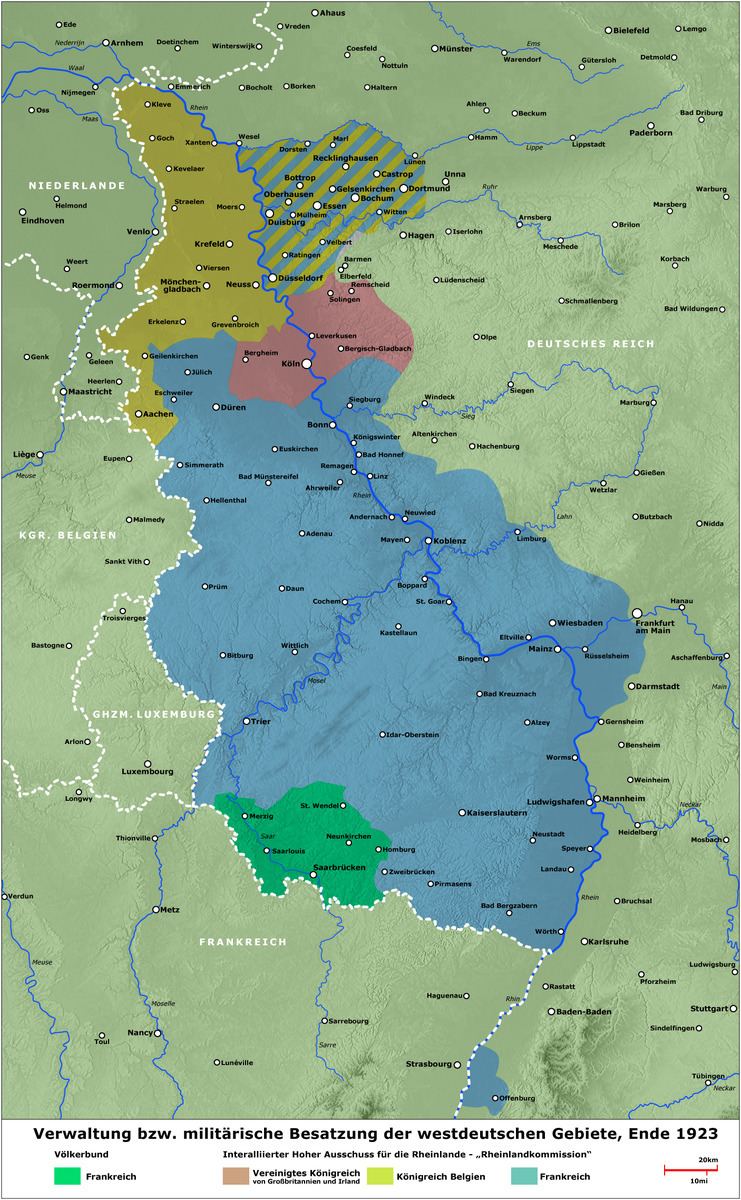 | ||
The Allied occupation of the Rhineland took place following the armistice that brought the fighting of World War I to a close on 11 November 1918. The occupying armies consisted of American, Belgian, British and French forces. The terms of the armistice provided for the immediate evacuation of German troops from Belgium, France, and Luxembourg as well as Alsace-Lorraine within 15 days.
Contents
French forces continued to occupy German territory in the Rhineland until the end of 1930, while France continued to control the smaller Saarland region until 1935.
Periods
Belgian forces
This consisted of five divisions with its headquarters at Aachen, and with its troops stationed in Krefeld.
British forces
The British Army entered German territory on 3 December 1918. The British Army of the Rhine was established as the occupying force in March 1919. Based at Cologne, they published The Cologne Post.
French forces
The French Eighth Army and Tenth Army originally constituted the French forces involved in the occupation. On 21 October 1919, they were combined to form the French Army of the Rhine.
In 1919 France stationed between 25,000 and 40,000 French colonial soldiers in the Rhineland. Assaults by Black soldiers in the French occupation army on local women led to accusations of systemic rape and other atrocities targeting the German civilian population and attributed mainly to Senegalese Tirailleurs. The events resulted in a widespread campaign by the German right-wing press, which dubbed them as "The Black Shame" (Die schwarze Schande or Die schwarze Schmach) and depicted them as a form of French humiliation of the German nation. Furthermore, some German women married African soldiers from the occupying forces, while others had children by them out of wedlock (hence the disparaging label "Rhineland Bastards") and were considered to increase the public disgrace. General Henry Tureman Allen reported to the US Secretary of State that from the start of the occupation until June 1920 there were 66 cases of formal accusations against colored colonial troops, out of which there were 28 convictions, and admits there were many more unreported cases. Despite these occasional cases, "the wholesale atrocities by French negro Colonial troops alleged in the German press, such as the alleged abductions, followed by rape, mutilation, murder and concealment of the bodies of the victims are false and intended as political propaganda".
Ruhr occupation
In 1923, in response to German failure to pay reparations under the Treaty of Versailles, France and Belgium occupied the industrial Ruhr area of Germany, most of which lies across the river on the right bank of the Rhine, until 1925. Many Germans were killed during civil disobedience protests. e.g. against dismissal of German officials.
United States forces
The American forces originally provided around 240,000 men in nine veteran divisions, nearly a third of the total occupying force. General John Pershing, commander of the American Expeditionary Force (AEF) on the Western Front, established the Third Army for the purpose, under the command of Major General Joseph T. Dickman.
Third Army was assigned to occupy the northern sector of the Coblenz bridgehead. By July 1919, Third Army was disbanded, having been reduced to about 8,400 men, and was renamed the American Forces in Germany.
On 24 January 1923, the US Army withdrew from the occupation of the Rhine, vacating the Ehrenbreitstein Fortress, which was promptly occupied by the French.
